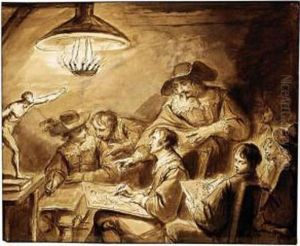Philippe Joseph Tassaert Paintings
Philippe Joseph Tassaert was a notable 18th-century Flemish painter, engraver, and a member of the Tassaert family, a dynasty of artists that left a significant impact on European art across generations. Born in Antwerp, Belgium, in 1732, Tassaert emerged from a lineage where artistry was both a tradition and profession, paving the way for him to delve into the artistic realm with an inherent sense of belonging and purpose.
Tassaert initially trained under the guidance of his father, who was also an artist, before embarking on a journey that would lead him to Paris, France. In Paris, he became associated with the Royal Academy of Painting and Sculpture, an institution that played a pivotal role in shaping the careers of many artists of the time. Tassaert's work in Paris allowed him to gain recognition and patronage, contributing significantly to his development and success as an artist.
His oeuvre primarily included historical and mythological scenes, portraits, and genre paintings, showcasing a profound mastery of emotion and a delicate sensitivity to detail. Tassaert's style was deeply influenced by the Rococo movement, which was prevalent during his early years, but he gradually transitioned towards a more Neoclassical approach, reflecting the changing tastes and philosophical outlooks of his era.
Despite his Belgian origins, Philippe Joseph Tassaert spent the majority of his career in France, where he absorbed and contributed to the rich cultural and artistic environment. His works were widely appreciated for their elegance, narrative depth, and technical skill. Tassaert's legacy is not only preserved through his paintings but also through his influence on subsequent generations of artists, including his own descendants, who continued to play significant roles in the European art scene.
Philippe Joseph Tassaert passed away in 1803, leaving behind a rich body of work that continues to be studied and admired for its historical significance and artistic beauty. His contributions to the art world have cemented his place as an important figure in the transition between the Rococo and Neoclassical periods, offering valuable insights into the evolution of European art.
